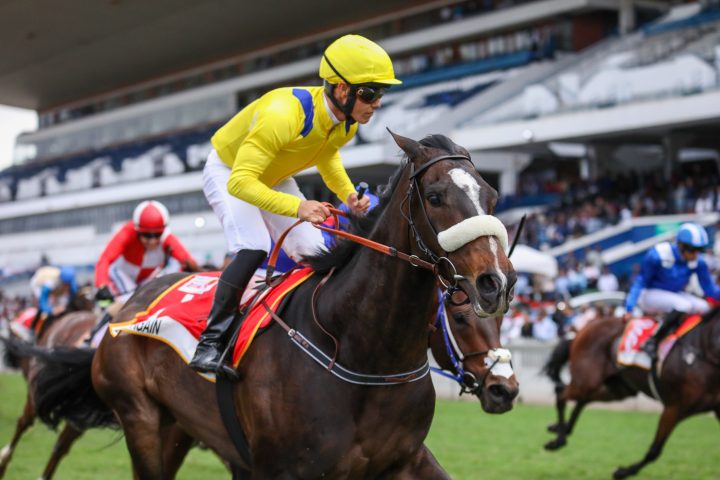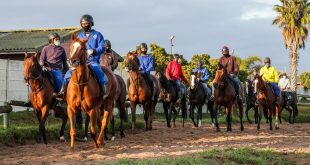Do It Again will win the Vodacom Durban July this year if one historical pointer repeats itself.
There have been six horses who have won the big race twice, but the three previous dual winners to Do It Again all ended their sequence on a year ending in zero.
Pamphlet won it in 1918 and 1920, Milesia Pride won it in 1949 and 1950 and El Picha won it in 1999 and 2000.
Can Do It Again keep up this trend by winning it in 2018, 2019 and 2020 and thus become the first in history to win it three times?

El Picha was trained by five times SA champion trainer Geoff Woodruff.
His father-in-law, the late great trainer Terrance Millard had trained a number of good horses from Argentina, including July winners Tecla Bluff and Illustrador as well as the immortal Empress Club.
After his retirement in 1991 he continued his purchasing journeys to Argentina on behalf of Woodruff and his son Tony.
One day in the mid-1990s his shipping agent phoned him to tell him there was one space left in the jet stall he had paid for and would he like to fill it.
Millard immediately thought of a small black horse who had caught his eye but had ultimately failed to make it on to his shortlist. He managed to secure this horse, El Picha, for $15,000.
Woodruff described El Picha yesterday, “He was right up there with the best I have trained, although I would not say the best. He was easy as pie to train and one of my favourites. He was laid back and a friend to everybody and I think he knew that.”
The 1994-born gelding by Tough Critic won seven races in Cape Town, including the Grade 3 Peninsula Handicap over 1800m.
However, the key to his success could have been Woodruff’s move to train in Johannesburg.
Woodruff revealed to the Racegoer a few years ago that El Picha had a naturally low “blood count” but in his first three months on the Highveld his blood count improved “out of sight.” Horses at that altitude have to be worked harder in order to get fitter because the thinner air provides less oxygen and El Picha began to thrive. In his second start on the Highveld he finished fifth in the Grade 1 Champions Stakes, beaten five lengths by Fort Defiance, and he then travelled down to Durban. After running a three-quarter length third in the Greyville 1900 from a wide draw he was set to carry just 53kg in the July. Robbie Hill rode a peach of a race from a wide draw and he denied Classic Flag a July double by 0,75 lengths.
As a five-year-old El Picha won the Summer Cup, finished second in the Met, second in the Grade 2 Colorado King Stakes, second in the Grade 1 Champions Stakes at Turffontein and then easily won the Grade 3 Jubilee before defending his July crown under Anton Marcus with a hair’s breadth victory over Young Rake despite carrying top weight of 58kg. He went on to win a Grade 1 over 2000m at Clairwood. That was the last race he won but he did well enough to continue racing until the end of his seven-year-old season.
Woodruff said he then proved to be a “useless” showjumper and thus spent the rest of his life, until the age of 22, happily eating grass in a paddock at Randjesfontein together with his pony friend “Andy.”
Racing historian Jay August wrote about Milesia Pride in his informative facebook page Notable South African Thoroughbreds.
Milesia Pride, a chestnut who stood at about 16 hands, was bought in Ireland by Mr JT Amery of KZN for £1150. The 86-year-old Amery had harboured the desire to win the “July” for near fifty years but had managed just one third place in 1918 with a horse named Draughtsman and two unplaced efforts in 1916 and 1945. Milesia Pride arrived by boat in Cape Town and was later sent to the yard of Jim Morrison.
Imported unraced horses were only allowed to run in Top Division events in those days, so Milesia Pride, having to start his career as a two-year-old running against top older horses, finished unplaced in his first five starts. He then claimed a fourth place and then ran second in the Kings Cup. He then won a top division race to secure his July place. After two sharpeners he won the 1949 July comfortably under Tiger Wright carrying 49kg. He thus became the second youngest horse to win the July Handicap, at 39 months of age, the only younger one being two-year-old Nobleman in 1911.
Milesia Pride won the July narrowly in 1950 under Basil Lewis carrying 57kg. He was unlucky in 1951, finishing seventh carrying 62kg. He had one more attempt at the big race in 1953 and was later retired to stud.
He only produced one foal to race and was put back into training in Bloemfontein where he was to pass away of what racing writer Mordaunt Milner suspected might have been a “broken heart.”
Milesia Pride’s sire Montrose was the first horse to sire the winner of four “July’s” and the first to sire three individual winners
According to Jean Jaffee’s book, They Raced To Win, Pamphlet was imported by Mr A. Britton (the racing nom-de-plume of Albert Lavenstein) from Britain at the same time as Trocko, who won the Johannesburg Summer Handicap in 1916.
Pamphlet won that race in 1917 before going on two win his two Durban Julys.
Pamphlet was reportedly a huge horse who according to renowned industry an Alex Robertson would have done justice to a team of “vanners” (Gypsy Cob horse).
Although, he looked like a stallion while in training he proved “useless” at stud, the best of his progeny being the filly Pavlova who finished second in the 1929 Summer Handicap.
By David Thiselton








